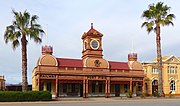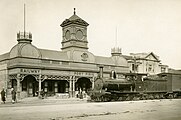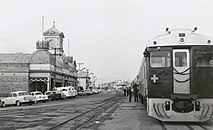| Port Pirie (Ellen Street) railway station | |||||||||||||
|---|---|---|---|---|---|---|---|---|---|---|---|---|---|
 Ellen Street station building is now a museum owned by the National Trust of South Australia Ellen Street station building is now a museum owned by the National Trust of South Australia
| |||||||||||||
| General information | |||||||||||||
| Location | 73–77 Ellen Street, Port Pirie, South Australia | ||||||||||||
| Coordinates | 33°10′33″S 138°00′37″E / 33.1759°S 138.0104°E / -33.1759; 138.0104 | ||||||||||||
| Owned by | South Australian Railways until 1967; now National Trust of South Australia | ||||||||||||
| Line(s) | Narrow gauge: – Port Pirie to Gladstone, built 1875–1878 – to Petersburg 1881 – to New South Wales border 1888 Broad gauge: – to Redhill 1937 | ||||||||||||
| |||||||||||||
Ellen Street railway station was the second of six stations that operated successively between 1875 and the early 2010s to serve the rural maritime town (later city) of Port Pirie, 216 km (134 mi) by rail north of Adelaide, South Australia. Soon after construction of the line towards Gladstone began in 1875, an impromptu passenger service commenced. The inaugural station, Port Pirie South, was 800 metres (870 yards) from the centre of the town. Since two tracks had already been laid down the middle of Ellen Street to the wharves, a small corrugated iron shed was erected as a ticket and parcels office. The street-side location was unusual for the South Australian Railways. In 1902, when passenger traffic had increased greatly, a stone building was erected in a striking Victorian Pavilion style. After the tracks were removed in 1967 and the station closed, the building's design assured its retention as a museum of the National Trust of South Australia.
| Links to the articles about stations in Port Pirie | |||||
| Station | Duration | Gauge | |||
|---|---|---|---|---|---|
| 1 | Port Pirie (at what became known as Port Pirie South) | 1876 to after 1911 | ng | ||
| 2 | Ellen Street (this article) | 1902–1967 | ng | bg* | |
| 3 | Solomontown | 1911–1967 | ng | ||
| 4 | Port Pirie Junction – also signposted as, and known colloquially as, Solomontown | 1937–1967 | ng | bg | sg |
| 5 | Mary Elie Street | 1967–1989 | bg | sg | |
| 6 | Coonamia stopping place | 1st, 1929 to after 1937 2nd, 1989–2010s |
sg | ||
| * In 1937, one of the two narrow-gauge tracks along Ellen Street was made dual-gauge by the addition of broad-gauge rails. Gauges are shown in these colours: narrow, broad and standard. | |||||
| Port Pirie's six stations and the "multi‑gauge muddle" | |||||
|---|---|---|---|---|---|
| At various times during a period of close to 140 years, Port Pirie had six railway stations – never more than two concurrently. During the 45-year period 1937–1982, the city became well known as one of the few locations in the world having three railway gauges. This situation was a result of South Australia's slow transition from lightly constructed narrow gauge to heavy-rail broad gauge (which predominated in the state at the time), then to standard gauge when lines between the mainland state capitals were at last unified. As a consequence, all Port Pirie stations that succeeded the inaugural station of 1876 were either built to accommodate a change of gauge or were affected by one. The timeline, reasons for change, and gauges involved are shown in the following graphic. Timeline of Port Pirie's six railway stations  |

Placement
Some time after the South Australian Railways commenced building a narrow-gauge (1067 mm / 3 ft 6 in) line inland from Port Pirie in 1875, track was extended about 900 metres (985 yards) from where the line had ended, the town's wharves. Two-thirds of this track was laid in Ellen Street, Port Pirie's main thoroughfare; the 30.5 metre (100 foot) width of the street provided ample room to lay a pair of tracks down the middle. For the first 13 years the line carried agricultural produce from the hinterland to the wharves for export – the purpose for which the government had built it. However, after 1888 the line also moved large amounts of silver-lead-zinc ore to Port Pirie from the New South Wales border near Broken Hill, 351 km (218 mi) away. Since the smelters had been built next to the northern end of the wharves, Ellen Street saw most of the inwards freight tonnage for Port Pirie, and sulphuric acid (a by-product sold to a fertiliser factory) outwards.
It was into this busy scene that the SAR decided, in late 1900, to introduce an on-street station for passenger services 400 metres (440 yards) short of the smelter gates. Tenders were called in June 1901 but offers were considered too high, so government employees built it. The keys were handed over without ceremony on 4 November 1902. The cost was £3760.
Construction
The station comprised a single-storey building, with a full-length veranda over the footpath, and a smaller building behind. There was none of the infrastructure usually present around stations, since there was no railway yard, only the double tracks going past. The design was in a striking Victorian Pavilion style, uniquely among South Australian Railways buildings. Its structure was stone with some brick, with a facade largely finished with pressed steel panels. The roof was corrugated iron; three domes were finished in large zinc shingles. Stairs were built in the central dome to allow the clocktower above it to be used as a lookout.
Operation

As a terminus for passenger trains on a through route to the nearby smelters, the station lacked a turning facility for locomotives. In the days of the narrow gauge, the double track provided a loop allowing locomotives to run around the train to re-couple and haul it back. In 1937, one of the two narrow-gauge tracks in Ellen Street was modified to dual gauge for broad-gauge trains connecting with Adelaide on a new, much more direct route via a line from Redhill. There was no other broad-gauge track to run around the train; it therefore became necessary for the locomotive to push its consist backwards at very slow speed for 920 metres (1010 yards) on the public thoroughfare, under the guidance of the train’s guard.
Pressure to close
As motor vehicle traffic increased, freight and passenger trains were increasingly regarded as a hindrance in Ellen Street. In 1943, the Port Pirie Council urged the SAR to build a terminal passenger station at Mary Elie Street and remove all trains from Ellen street. The bid was unsuccessful; however, a councillor observed that the solution "did not seem a practical scheme in wartime, but it must be kept alive". In the meantime the council asked the railways to provide a safer area to the north of the station by bituminising between the rails and installing lights: since the brake van – the last vehicle – was positioned in front of the station to allow passengers to retrieve their baggage and other people to collect parcels in the least possible time, passengers from the front (northernmost) carriages had to climb down to street level well beyond from the station building on to a poorly lit surface.
Closure

Like four of Port Pirie's six railway stations, Ellen Street was superseded as a consequence of lines being constructed to wider gauges eventually entering the city. From 1970, when a standard-gauge line from Sydney via Broken Hill would be completed, a 213-metre (700-foot) platform would be necessary to provide for passengers on far longer trains to transfer across between broad and standard gauge. Unlike the arrival of the broad gauge in 1937, which was solved by adding a third rail down the street, this time a completely new station would be needed. In November 1967, a new station was opened in Mary Elie Street and Ellen Street station was closed – 24 years after the Port Pirie Council had requested it.
After the standard gauge arrived and narrow-gauge operations ceased, all tracks in Ellen Street tracks were pulled up. Since the smelters beyond the station still had to be supplied with ore from Broken Hill, new standard gauge tracks paralleling the street were laid along the narrow corridor between the station building and the wharves.
Museum
Externally unaltered since its erection in 1902, the building retains its prominent place in Port Pirie as a National Trust of South Australia museum, 56–57 years since it closed as a station.
Th building was listed on the National Trust of South Australia's Register of Historic Places in 1977, the now-defunct Register of the National Estate in 1978 and the South Australian Heritage Register in 1981.
Preceding station: Inaugural Port Pirie station, located at Port Pirie South.
Concurrent stations: Solomontown and Port Pirie Junction.
Subsequent station: Mary Elie Street.
Gallery
 |
 |
 |
||||
| About 1900, there was ample space in Ellen Street for the small, short narrow-gauge trains to share the thoroughfare with pedestrians and horse-drawn vehicles | About 1904, passengers alighting after the long, roundabout journey from Adelaide were greeted outside the new station | About 1920, and motor vehicles (including two open buses in the foreground) were becoming more common | ||||
 |
 |
 | ||||
| About 1930 and seven years before the broad gauge arrived, trains were hauled by diminutive locomotives such as the Y class | In 1940, a 620 class locomotive and passenger cars that were typical of the broad-gauge years 1937–1967 (and their problematic size and length) | Fast, roller-bearing 520 class locomotives introduced in 1943 were ideal for the easy route to Port Pirie (early 1950s photo) | ||||
 |
 |
 |
||||
| The brake van on passenger trains had to be positioned outside the station building to transfer parcels and boxes into the building or on to road trucks (1947 photo) | Shunting often took place on the narrow-gauge tracks in front of Ellen Street station, as with this T class steam locomotive near the Alexander Street intersection in 1963 | In the 1960s, smooth-riding airconditioned Bluebird railcars kept the Adelaide–Port Pirie service popular (1962 photo) |
See also
Notes
- The gauges were 1067 mm (3 ft 6 in), 1435 mm (4 ft 8+1⁄2 in), and 1600 mm (5 ft 3 in).
- The track in Ellen Street went from 33°10′51″S 138°00′42″E / 33.1807°S 138.0117°E / -33.1807; 138.0117 to 33°10′26″S 138°00′43″E / 33.174°S 138.012°E / -33.174; 138.012.
- A typical Port Pirie broad gauge consist comprised, after the locomotive, two boxcars fitted with passenger-service bogies, three or four steel country-services passenger cars, a "long Tom" 12-wheel brake van, in later years a cafeteria car, and often one or more freight cars (especially those with urgent interstate cargo). Steam locomotives were usually a 620 class 4-6-2, a 600 class 4-6-2, or, after their construction in 1943, a 520 class 4-8-4, which were well suited to running at up to 113 km/h (70 mph) over the relatively flat route to Adelaide. Increasingly during the 1960s, 900 class diesels undertook the task.
- The Port Pirie Junction station was closed at the same time.
References
- ^ National Trust Register of Historic Places no. 702. Burnside: National Trust of South Australia. 28 April 1969. p. 702.
- "South Australia's mixed gauge muddle" (PDF). National Railway Museum . National Railway Museum. 2013. Archived from the original (PDF) on 28 February 2016. Retrieved 14 August 2019.
- Bakewell, Guy; Wilson, John (September 1968). "Farewell to Ellen Street". Australian Railway Historical Society Bulletin. Redfern: Australian Railway Historical Society. pp. 210–213.
- Ward, Andrew (1982). Railway Stations of Australia. South Melbourne: MacMillan Company of Australia. pp. 60–61. ISBN 0333338537.
- ^ Ward, Andrew (1982). Railway Stations of Australia. South Melbourne: MacMillan Company of Australia. pp. 60–61. ISBN 0-333338-53-7.
- "Port Pirie railway station". National Trust SA. National Trust of South Australia. 2019. Retrieved 4 February 2020.
- ^ "Pirie terminus". The Recorder (Port Pirie). No. 12, 371. (Original, Port Pirie. Digital reproduction, Canberra: National Library of Australia – Trove digital newspaper archive). 31 March 1943. p. 1. Retrieved 13 September 2019.
- "Locomotive 523 - Essington Lewis". National Railway Museum. 2019. Retrieved 13 September 2019.
- Webb, G.R. (1976). "The planning and evaluation of rail standardisation projects in Australia" (PDF). Australasian Transport Research Forum. Retrieved 13 September 2019.
- Bakewell, Guy; Wilson, John (September 1968). "Farewell to Ellen Street". Australian Railway Historical Society Bulletin. Redfern: Australian Railway Historical Society. pp. 210–213.
- "Port Pirie Railway Station". National Trust of Australia. Retrieved 7 August 2019.
- Wotton, David C. (26 November 1981). "South Australian Heritage Act, 1978-1980, Entry of Items on the Register of State Heritage Items—continued" (PDF). The South Australian Government Gazette. Government of South Australia. p. 2177. Retrieved 7 February 2020.
Former Railway Station ... 73-77 Ellen Street, Port Pirie 5540.
- "Railway Station (former), 73 -77 Ellen St, Port Pirie, SA, Australia - listing on the now-defunct Register of the National Estate (Place ID 6949)". Australian Heritage Database. Australian Government. 21 March 1978. Retrieved 9 February 2020.
- Port Pirie
- Disused railway stations in South Australia
- Railway stations in Australia opened in 1902
- Railway stations in Australia closed in 1967
- South Australian Heritage Register
- South Australian places listed on the defunct Register of the National Estate
- Buildings and structures in Port Pirie
- National Trust of South Australia